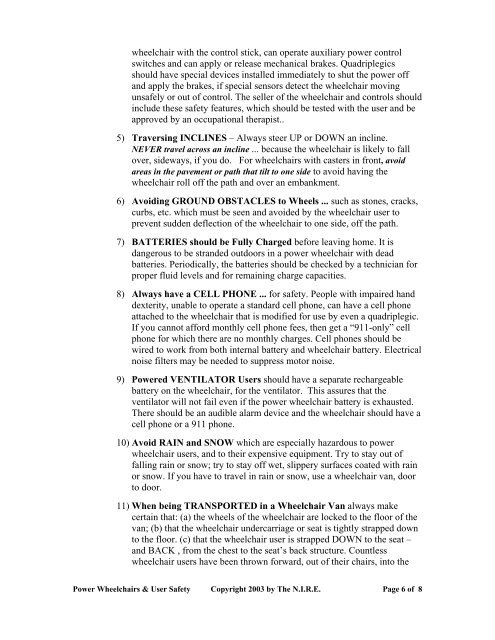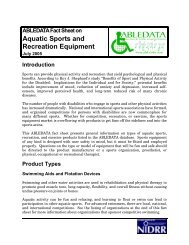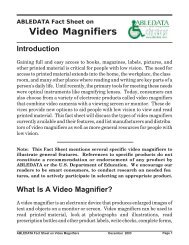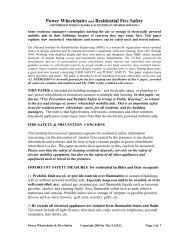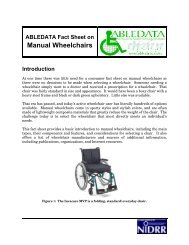Power Wheelchairs and User Safety - AbleData
Power Wheelchairs and User Safety - AbleData
Power Wheelchairs and User Safety - AbleData
You also want an ePaper? Increase the reach of your titles
YUMPU automatically turns print PDFs into web optimized ePapers that Google loves.
wheelchair with the control stick, can operate auxiliary power control<br />
switches <strong>and</strong> can apply or release mechanical brakes. Quadriplegics<br />
should have special devices installed immediately to shut the power off<br />
<strong>and</strong> apply the brakes, if special sensors detect the wheelchair moving<br />
unsafely or out of control. The seller of the wheelchair <strong>and</strong> controls should<br />
include these safety features, which should be tested with the user <strong>and</strong> be<br />
approved by an occupational therapist..<br />
5) Traversing INCLINES – Always steer UP or DOWN an incline.<br />
NEVER travel across an incline ... because the wheelchair is likely to fall<br />
over, sideways, if you do. For wheelchairs with casters in front, avoid<br />
areas in the pavement or path that tilt to one side to avoid having the<br />
wheelchair roll off the path <strong>and</strong> over an embankment.<br />
6) Avoiding GROUND OBSTACLES to Wheels ... such as stones, cracks,<br />
curbs, etc. which must be seen <strong>and</strong> avoided by the wheelchair user to<br />
prevent sudden deflection of the wheelchair to one side, off the path.<br />
7) BATTERIES should be Fully Charged before leaving home. It is<br />
dangerous to be str<strong>and</strong>ed outdoors in a power wheelchair with dead<br />
batteries. Periodically, the batteries should be checked by a technician for<br />
proper fluid levels <strong>and</strong> for remaining charge capacities.<br />
8) Always have a CELL PHONE ... for safety. People with impaired h<strong>and</strong><br />
dexterity, unable to operate a st<strong>and</strong>ard cell phone, can have a cell phone<br />
attached to the wheelchair that is modified for use by even a quadriplegic.<br />
If you cannot afford monthly cell phone fees, then get a “911-only” cell<br />
phone for which there are no monthly charges. Cell phones should be<br />
wired to work from both internal battery <strong>and</strong> wheelchair battery. Electrical<br />
noise filters may be needed to suppress motor noise.<br />
9) <strong>Power</strong>ed VENTILATOR <strong>User</strong>s should have a separate rechargeable<br />
battery on the wheelchair, for the ventilator. This assures that the<br />
ventilator will not fail even if the power wheelchair battery is exhausted.<br />
There should be an audible alarm device <strong>and</strong> the wheelchair should have a<br />
cell phone or a 911 phone.<br />
10) Avoid RAIN <strong>and</strong> SNOW which are especially hazardous to power<br />
wheelchair users, <strong>and</strong> to their expensive equipment. Try to stay out of<br />
falling rain or snow; try to stay off wet, slippery surfaces coated with rain<br />
or snow. If you have to travel in rain or snow, use a wheelchair van, door<br />
to door.<br />
11) When being TRANSPORTED in a Wheelchair Van always make<br />
certain that: (a) the wheels of the wheelchair are locked to the floor of the<br />
van; (b) that the wheelchair undercarriage or seat is tightly strapped down<br />
to the floor. (c) that the wheelchair user is strapped DOWN to the seat –<br />
<strong>and</strong> BACK , from the chest to the seat’s back structure. Countless<br />
wheelchair users have been thrown forward, out of their chairs, into the<br />
<strong>Power</strong> <strong>Wheelchairs</strong> & <strong>User</strong> <strong>Safety</strong> Copyright 2003 by The N.I.R.E. Page 6 of 8


